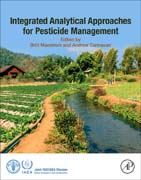
Pesticide Management for Food Safety Control: Integrated Analytical Approaches provides proven laboratory practices/examples and methods necessary in analysis to control pesticides in food and water in various environments. This is a practical and useful reference to anyone in a laboratory setting needing a systematic way to detect and control agricultural contaminants for a safe food supply. This reference provides insight into good laboratory practices and examples of methods used in individual specialist laboratories enabling stakeholders in the agri-food industry to appreciate the importance of proven, reliable data and the associated quality assurance approaches for end product testing for toxic levels of contaminant residues in food. The book is written in a rigorous but simple way to make sure that a broad range of readers can appreciate the technical content. A number of information sources are included for further consultation by the laboratories. It is the very practical nature of the book as well as the generic guidelines that distinguishes it from others in the market which makes it unique. Provides coverage of risk assessment and effective testing technologiesCovers generic guidelines on pesticide analysis on different environmental matrices for use to the developed and developing worldPresents the most up-to-date information in research sample testing preparation and method validation to detect pesticide residues in foodIncludes examples of each method for practical applicationDemonstrates proven, reliable research data and the associated quality assurance approaches for end product testing for food, water, and soil sedimentDescribes the concept of integrated analytical approaches for pesticide management practices INDICE: 1. Introduction 2. Generic guidelines on integrated analytical approaches to assess indicators of pesticide management practices at a catchment scale. Black-box monitoring and the laboratory's role in fostering good agricultural practice 3. Sampling strategies 4. Implementation and optimization of soil sampling: some practical guidance and considerations 5. Ecological Risk Assessment of Pesticides Used in Agriculture 6. Biodiversity and Biomonitoring Indexes 7. Use of biomarkers for studying the effects of pesticides on freshwater organisms 8. Overview of Analytical Methodologies and Techniques for Pesticide Residue Analysis 9. Pesticides in water, soil and sediments 10. Quality control measures at the analytical laboratory 11. The use of nuclear techniques for environmental studies 12. Easy to use pesticide fate/effects modelsand statistical tools 13. Environmental Risk Indicators: Their Potential Utility in Pesticide Risk Management and Communication 14. Remediation and Mitigation Strategies 15. Integrated Analytical Monitoring 16. Assessment of potential risks and effectiveness of agrochemical usage in a catchment: a case study of the Nzoia Nucleus Estate sugarcane farms in western Kenya 17. Indicators of Good Agricultural Practises in Viticulture 18. Conclusions and recommendations Appendix 1. Description of the Pesticide Impact Rating Index (PIRI) 2. Framework for sampling for pesticides in water/sediments 3. Sampling tools and procedures 4. Linking soil and pesticide behaviour at a landscape scale: the way forward to opening the black-box 5. Biomonitoring validation 6. Interpreting water and soil monitoring parameters
- ISBN: 978-0-12-816155-5
- Editorial: Academic Press
- Encuadernacion: Rústica
- Páginas: 350
- Fecha Publicación: 01/07/2018
- Nº Volúmenes: 1
- Idioma: Inglés
